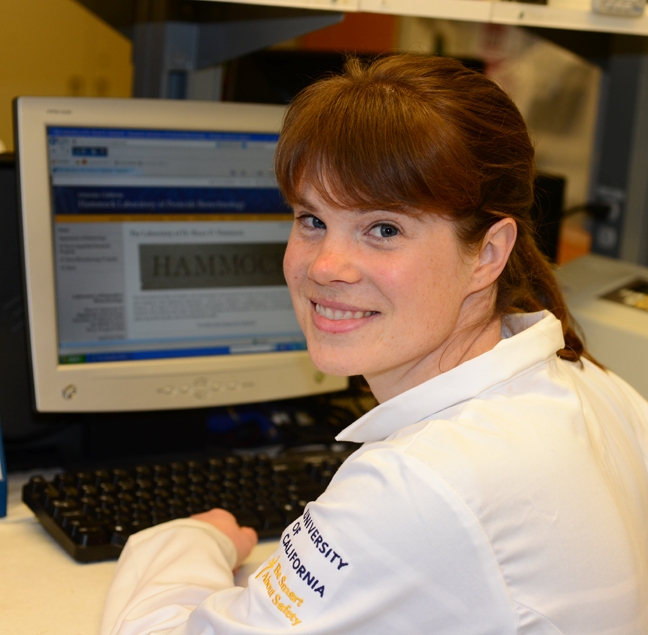- Author: Kathy Keatley Garvey
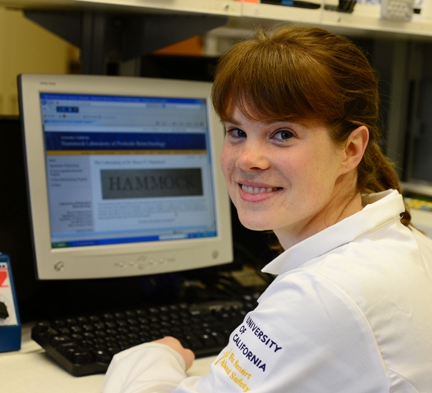
Science intrigues her, fulfills her, and propels her.
Rand, who is drawing widespread recognition for her work with omega-6 fatty acids as a postdoctoral researcher in Bruce Hammock's biological analytical lab at UC Davis, says science is both “exciting and rewarding.”
“Science and chemistry were my two favorite subjects in school,” said Rand, who was born in Bermuda but grew up in Nova Scotia, Canada. “I had excellent teachers that really fueled my interest. It was their enthusiasm. I remember my eighth grade math teacher leaping up on a table to get her point across about the Pythagorean theorem, and my 11th grade chemistry teacher used memorable metaphors to explain challenging concepts. Both my parents were biologists, and growing up in Eastern Canada we went on many outdoor trips. The combination of motivational teachers and exploring the natural world fueled my interest to continue in science professionally.”
Rand thinks of science “as a way to connect with the world in many ways, by working to understand it better, collaborating with a network of scientists, and communicating science to the public. Science matters because of its diversity: it heals, transforms, innovates, and understands, all of which globally shape our world.”
Rand, who holds a bachelor of science degree in chemistry from Mount Allison University, Canada and a doctorate in environmental chemistry at the University of Toronto, joined the Hammock lab in 2013 and was named a fellow on the Oncogenic Signals and Chromosome Biology T32 Training Grant, Department of Microbiology and Molecular Genetics.
In the Hammock lab, Rand studies omega-6 fatty acids, or technically, “the regulation of cancer angiogenesis from the metabolism of epoxy omega-6 fatty acids.”
How does Amy Rand explain to the average layperson what she does?
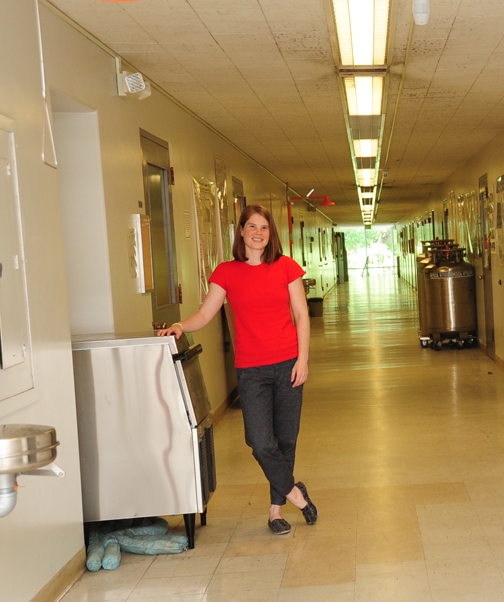
"Amy took on one of the most demanding projects in the laboratory in asking how a group of natural compounds regulate angiogenesis," said Hammock, a distinguished professor of entomology who holds a joint appointment with the UC Davis Department of Entomology and the UC Davis Comprehensive Cancer Center.
In April of 2016, Rand drew international accolades when she received a prestigious career development award from the American Association for Cancer Research—the two-year $100,000 Judah Folkman Fellowship for Angiogenesis Research. She won the highly competitive international award for her proposal, “Regulation of Cancer Angiogenesis from the Metabolism of Epoxy Omega-6 Fats.”
Cancer researchers praised her for her potential as a future leader in the field of angiogenesis research.
“We're so proud of her,” said Hammock, who directs the campuswide Superfund Research Program, National Institutes of Health Biotechnology Training Program, and the National Institute of Environmental Health Sciences (NIEHS) Combined Analytical Laboratory.
Hammock and Rand collaborate with Harvard Medical School professor Dipak Panigrahy, former researcher in the Hammock lab and a fellow in the late Professor Judah Folkman's angiogenesis research lab. Folkman, the father of angiogenesis research, is best known for pioneering the concept of blocking angiogenesis or the development of blood vessels, to control cancer growth. "This concept has resulted in a number of anti-cancer drugs and has had a major impact on cancer treatment,” Hammock said. “Of course blood vessel development is also critical for survival."
Looking back, Rand related that her Ph.D research “focused on our exposure to fluorinated commercial materials, their resulting metabolism, and how the metabolites might affect our health. While my Ph.D training was heavily focused on analytical chemistry and metabolic characterization, I wanted more formal training on the biological and biochemical mechanisms associated with disease. I've always been interested in research that combines chemistry and biology to enhance our understanding of human health.”
Rand encourages students to follow their dreams, to pursue what interests them, “if they're able, regardless the subject. I wouldn't be where I am without balancing science with other parts of my life, like performing music during graduate school, which allowed me to come back to the lab with fresh inspiration for next steps. But we need to motivate people, especially minorities, to continue in science, because people from different backgrounds and experiences are necessary for creating a collective mind that does effective scientific research and innovation.”
When she started her postdoctoral research, moving across the continent to Davis, she knew few people. “Within a short time, I fell into a great community of people at the local climbing gym, that have sparked many outdoor adventures - climbing, backpacking, swimming, and skiing - over the past 3 years. Living in Northern California has been a real treat!”
She also has a soft spot for entomology. “Growing up, I used to swim insects to shore if I found them floating far from it - I was alarmed to see them nearly drowning, and did my part to help. That might have been what initiated my future role as lifeguard and swimmer.”
Hammock says his own long-term interest in nature and biology “was fostered by a wonderful scoutmaster who thought kids should be wandering in the woods, and a great biology teacher who provided a microscope to me in high school and said 'go discover.' The move to entomology was further stimulated when I realized that the big cause of human suffering in the world was starvation caused in part by insects eating crops. It was also stimulated by realizing that insect-borne diseases dwarf cancer, heart disease, etc., in terms of human suffering. It is hard to know where science leads.”
As for where science leads, Rand has just accepted a position as assistant professor of organic toxicology in the chemistry department, Carleton University in Ontario. She starts her position Sept. 1.
“We really hate to lose her,” Hammock said, “but we're happy for her; this is a really nice position. And, we'll still be collaborating.”
"I hope we collaborate for the next 80 years or so," he quipped.
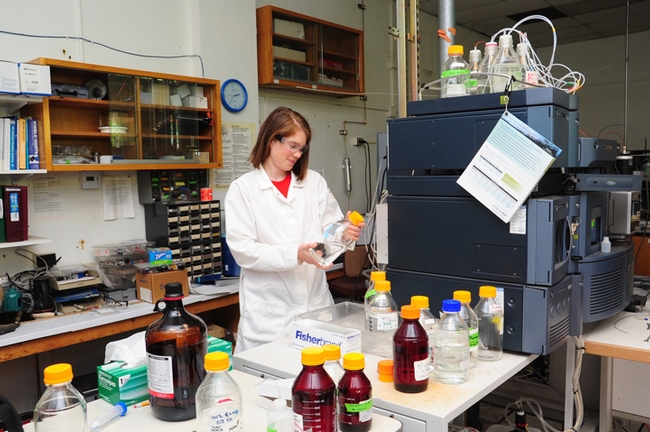
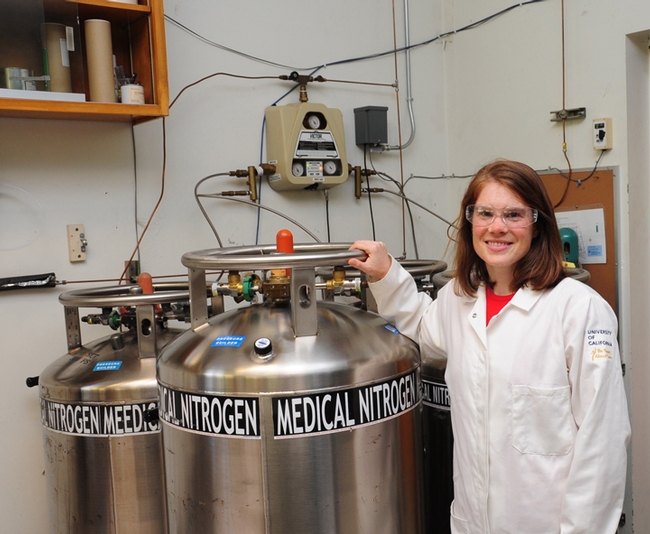
- Author: Kathy Keatley Garvey
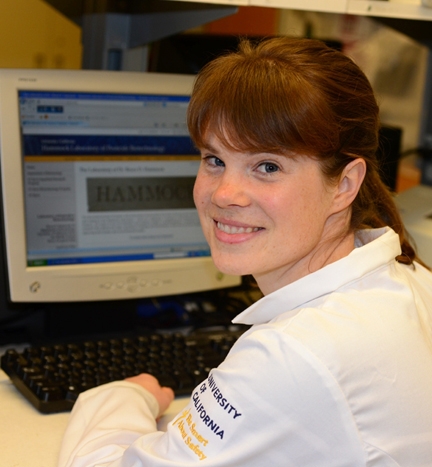
Earlier research by the Judah Folkman laboratory of Harvard Medical School showed that cutting off blood vessels that feed a cancerous tumor can stop its growth.
The seven-member research team—five from the Bruce Hammock laboratory of UC Davis—“characterized a novel lipid signaling molecule that can change fundamental biological processes involved in our health and disease,” said lead author and researcher Amy Rand. “We've found that a novel product derived from the metabolism of omega-6 fatty acids stimulates angiogenesis, which may contribute to enhanced tumor growth by providing tumors with oxygen and nutrients.”
“As a highly regulated process, angiogenesis is critical for wound healing and development, but many diseases result in unregulated angiogenesis, including cancer,” explained Rand, a postdoctoral fellow in the lab of Bruce Hammock, a distinguished professor who holds a joint appointment with UC Davis Department of Entomology and Nematology and the UC Davis Comprehensive Cancer Center. “We may be able to control angiogenesis to stimulate wound healing when necessary, but also block tumor growth in patients. Diseases that rely on angiogenesis may be able to be treated in part by changes in dietary lipid exposure or by controlling levels of these metabolites through enzyme inhibitors that block their formation.”
The research, published April 10 in the Proceedings of the Natural Academy of Sciences (PNAS), explains, in part, why inhibiting the soluble epoxide hydrolase (sEH) in some systems is angiogenic whereas combining sEH inhibition with the inhibition of cyclooxygenase (COX) enzymes is dramatically antiangiogenic, which in turn may suppress tumor growth.
“There's uncertainty regarding the link between unsaturated fats and cancer, due to ongoing conflicts between scientific studies and insufficient data,” Rand said. “Because of this, there is a major gap in our understanding of how these essential dietary fats affect our health. We used tools to detect and characterize unknown metabolites from omega-6 unsaturated fats and determined their effect on angiogenesis, to address at least a small part of this uncertainty by focusing on how these fats contribute to cancer tumor growth.”
Hammock, who holds a joint appointment in the UC Davis Department of Entomology and Nematology and the UC Davis Comprehensive Cancer Center, said the research, titled “Cyclooxygenase-Derived Proangiogenic Metabolites of Epoxyeicosatrienoic Acids
Holds long term hope for cancer patients and those afflicted with heart, eye and other diseases. The team also included Christophe Morisseau, Bogdan Barnych, and Kin Sing Stephen Lee all of the UC Davis Department of Entomology and Nematology and UC Davis Comprehensive Cancer Center; Tomas Cajka of the UC Davis Genome Center; and Dipak Panigraphy of Harvard Medical School. Lee is now an assistant professor at Michigan State University.
“Pro and anti-angiogenic therapy can potentially help millions of people worldwide in various diseases such as heart, ulcers, eye and cancer as first demonstrated by Dr. Judah Folkman and his colleagues,” said Panigraphy, formerly of the Hammock lab and now with the Center for Vascular Biology Research, Beth Israel Deaconess Medical Center, Harvard Medical School, and the school's Department of Pathology.
“While the COX and sEH pathways can be targeted with drugs, their interaction is poorly understood,” Panigraphy said. “These studies by Rand et al demonstrate for the first time new specific mechanisms whereby targeting the sEH pathway can be both pro- and anti-angiogenic and has the potential to help patients with devastating diseases such as in the eye and cancer where blocking angiogenesis is desired.”
Rand, who received her doctorate in chemistry from the University of Toronto, Canada, in 2013, the same year she joined Hammock's biological analytical chemistry lab, said she's “always been interested in research that combines chemistry and biology to enhance our understanding of human health.”
Future work? “We aim to understand the direct involvement of these omega-6 fatty acid metabolites with cancer tumor growth and metastasis.”
Rand last year received the $100,000 Judah Folkman Fellowship for Angiogenesis Research from the American Association for Cancer Research. She won the highly competitive international award for her proposal, “Regulation of Cancer Angiogenesis from the Metabolism of Epoxy Omega-6 Fats.” Rand joined Hammock's biological analytical chemistry lab in 2013 and was a fellow on the Oncogenic Signals and Chromosome Biology T32 Training Grant, UC Davis Department of Microbiology and Molecular Genetics.
The late Judah Folkman (1933-2008), a Harvard Medical School professor considered the father of angiogenesis research, “is best known for pioneering the concept of blocking angiogenesis (the development of blood vessels) to control cancer growth," Hammock said. "This concept has resulted in a number of anti-cancer drugs and has had a major impact on cancer treatment. Of course, blood vessel development is also critical for survival."
Folkman discovered that cutting off the blood vessels that feed the tumor can stop cancer tumor growth. His revolutionary work has led to the discovery of a number of therapies based on inhibiting or stimulating neovascularization. Inhibitors of the sEH pathway are moving toward human trials to control neuropathic pain, but if combined with nonsteroidal anti-inflammatory drugs can block tumor growth by blocking angiogenesis. So Dr. Sung Hee Hwang combined inhibitors of both pathways into one molecule which is being investigated in cancer models at the UC Davis Cancer Center by Dr. Paul Henderson and Northwestern University Medical School by Dr. Guang-yu Yang.
Hammock directs the campuswide Superfund Research Program, National Institutes of Health Biotechnology Training Program, and the National Institute of Environmental Health Sciences (NIEHS) Combined Analytical Laboratory.
This work was supported by NIEHS and the NIEHS Superfund Program; and two of Rand's grants: the Oncogenic Signals and Chromosome Biology T32 Training Grant, NIH/NIEHS; and her 2016 AACR Judah Folkman Fellowship for Angiogenesis Research.
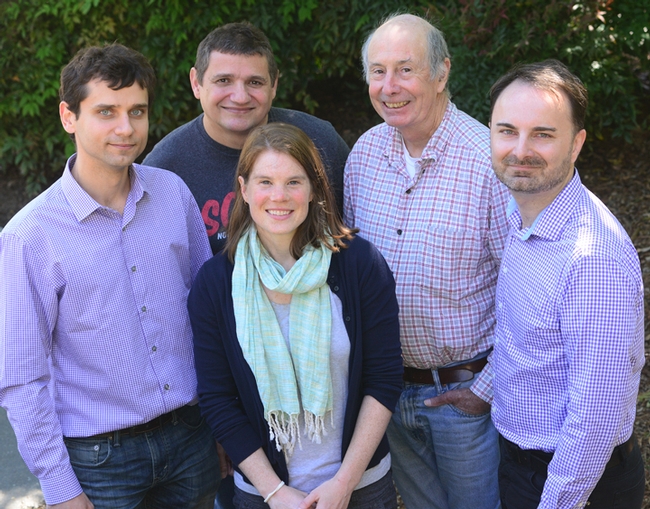
- Author: Kathy Keatley Garvey

Rand, honored at AACR's meeting April 19 meeting in New Orleans, won the highly competitive international award for her proposal, “Regulation of Cancer Angiogenesis from the Metabolism of Epoxy Omega-6 Fats.”
“We're so proud of her,” said Hammock, distinguished professor of entomology, UC Davis Department of Entomology and Nematology, who holds a joint appointment with the UC Davis Comprehensive Cancer Center.
Rand joined Hammock's biological analytical chemistry lab in 2013 and was a fellow on the Oncogenic Signals and Chromosome Biology T32 Training Grant, Department of Microbiology and Molecular Genetics, directed and administered by Wolf-Dietrich Heyer, professor and chair, Department of Microbiology and Molecular Genetics.
Hammock and co-advisor Kermit Carraway, professor in the Department of Microbiology and Molecular Genetics, co-sponsored her on the grant application.
Rand, who will begin the fellowship in July, was lauded for the relevance of her application to AACR's mission, the belief that it will have a significant impact, and in recognition of her potential as a future leader in the field of angiogenesis research.
“I've always been interested in research that combines chemistry and biology to enhance our understanding of human health,” Rand said, who received her doctorate in chemistry from the University of Toronto, Canada, in 2013.
“My Ph.D research focused on our exposure to fluorinated commercial materials, their resulting metabolism, and how the metabolites might affect our health,” she said. “While my Ph.D training was heavily focused on analytical chemistry and metabolic characterization, I wanted more formal training on the biological and biochemical mechanisms associated with disease.”
Her doctoral advisor, Scott Mabury, a UC Davis graduate, introduced her to Hammock. “In Professor Hammock's lab, I research how bioactive metabolites of epoxy omega-6 fatty acids influence cancer biology, by studying their effect on angiogenesis, tumor growth, and metastasis.”
Hammock and Rand collaborate with Harvard Medical School professor Dipak Panigrahy, former researcher in the Hammock lab and a fellow in Folkman's angiogenesis research lab.
"This is a tremendous honor for both Amy and the Hammock laboratory to be awarded the AACR Judah Folkman grant,” said Panigraphy. “Dr. Folkman was a scientific pioneer who established the field of angiogenesis. Amy's potentially paradigm shifting studies in the Hammock laboratory will carry on the Folkman legacy."
"The late Professor Judah Folkman is best known for pioneering the concept of blocking angiogenesis (the development of blood vessels) to control cancer growth," Hammock said. "This concept has resulted in a number of anti-cancer drugs and has had a major impact on cancer treatment. Of course blood vessel development is also critical for survival."
"Amy took on one of the most demanding projects in the laboratory in asking how a group of natural compounds regulate angiogenesis," Hammock said. "Based on her work with postdoctoral fellow Bogdan Barnych, they may be able to fine tune angiogenesis to stimulate wound healing when needed but block tumor development in patients."
Sung Hee Hwang, also a postdoctoral fellow in the Hammock laboratory, commented: "It appears that the work that Amy and Bogdan are doing could explain how one of my compounds is able to block tumor growth and metastasis."
Rand also has an active collaboration with with UC Davis biomedical engineer Kathy Ferrara.
Born and educated in Canada, Rand holds two other degrees: a bachelor of arts degree in music a and a bachelor of science degree in chemistry, both awarded by Mount Allison University, New Brunswick, Canada, in 2007.
Judah Folkman (1933-2008), considered the father of angiogenesis research, was a professor at the Harvard Medical School who directed the Children's Hospital Boston Surgical Research Laboratories, now the Vascular Biology Program, and served as the scientific director of the hospital's Vascular Anomalies Center. He is best known for his pioneering research on tumor angiogenesis. Cutting off the blood vessels that feed the tumor can stop cancer tumor growth, he said in his revolutionary work that has led to the discovery of a number of therapies based on inhibiting or stimulating neovascularization.
Applicants for the Judah Folkman Fellowship for Angiogenesis Research are postdoctoral or clinical research fellows with a medical degree or a combined M.D./Ph.D. who work in an academic, medical or research institution. They must be in first five years of their postdoctoral training. Proposed research projects are restricted to basic, clinical, translational or epidemiological projects that substantially advance the field of angiogenesis research in cancer.

- Author: Kathy Keatley Garvey
DAVIS--Cancer biology researcher Amy Rand, a postdoctoral researcher in the Bruce Hammock lab at the University of California, Davis. has been selected a fellow in the T32 Postdoctoral Training Program in Oncogenic Signals and Chromosome Biology.
“I will be looking at how metabolites of omega-3 fatty acids can protect against cancer,” Rand said. “A previous researcher in the Hammock lab was the first to find a specific metabolite that inhibited the formation of blood vessels which then suppressed the formation and spread of tumors. I aim to further explore the specific mechanism that links omega-3 fatty acid metabolism and their anti-cancer activity.”
“Omega-3 fatty acids are increasingly being used as dietary supplements, and are marketed for their many beneficial health effects,” she said, in explaining the significance of the project. “This research will help us to further clarify the specific relationship between the dietary exposure to and metabolism of omega-3 fatty acids and their role in the regulation of certain cancers.”
Wolf-Dietrich Heyer, professor and chair of the Department of Microbiology and Molecular Genetics and director of the T32 Training Grant in Oncogenic Signals and Chromosome Biology, praised Rand for her excellent qualifications, research plan and presentation. "We are confident that your postdoctoral studies in Dr. Hammock's laboratory will lead to significant new insights in cancer biology."
Her future goals? “I have a growing interest in research that lies at the interface between chemistry and biology. Becoming an academic researcher is something I would love to pursue; it would be a fantastic opportunity to explore the relationship between the dietary exposure and metabolism of chemical substances and their corresponding biological activity.”
Long interested in a scientific career, Rand said she's had several inspiring teachers, who played “a big role in my developed interest in the sciences. Becoming a scientist was attractive to me because you use a combination of critical thinking, observation, creativity, and patience to answer important questions. It's very satisfying to work hard at accomplishing a piece of the research puzzle, and then communicating the story that surrounds its significance.”
Rand, from Halifax, Nova Scotia, received bachelor degrees in music and chemistry from Mount Allison University, New Brunswick, in 2007 and her doctorate in environmental chemistry from the University of Toronto in 2013.
Hammock holds a joint appointment in the UC Davis Department of Entomology and Nematology and the UC Davis Comprehensive Cancer Center. He directs the campuswide Superfund Research Program, National Institutes of Health Biotechnology Training Program, and the National Institute of Environmental Health Sciences (NIEHS) Combined Analytical Laboratory.
